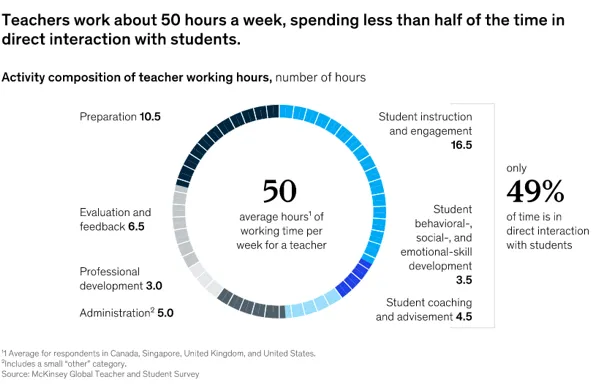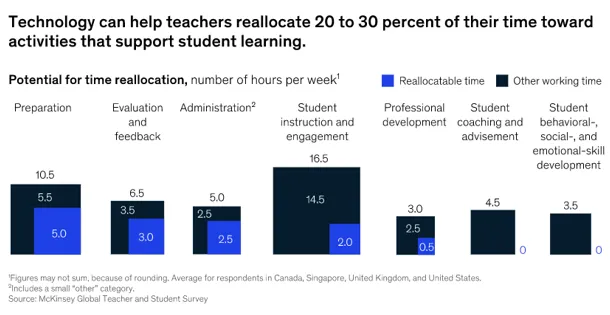Aura Group welcomes Darryl Tom as Managing Director, Private Wealth and Head of Family Office
Aura Group is delighted to welcome Darryl Tom to the role of Managing Director, Private Wealth and Head of Family Office. In this role, Darryl will...
Welcome to our two-part exploration into K-12 EdTech, a surprisingly underserved sector that is brimming with potential.

In this two-part series, we aim to pull back the curtain on the pressing challenges of the teaching profession and unveil the substantial opportunities for technological innovation and advancement within this space.
When it comes to the teaching profession, a “Great Resignation”-type scenario is genuine. Even prior to the pandemic, teachers faced significant workplace challenges, including high stress, long working hours, relatively low pay compared to other professions requiring similar education levels, and a lack of resources due to budgetary restraints. Once the pandemic hit, transitioning to remote or hybrid teaching added another layer of complexity and stress.
Reports suggest that many of today’s teachers are considering leaving the profession due to these challenges. In the US, 55% of educators are thinking about leaving the profession earlier than they had planned. Meanwhile in Australia, only 3 in 10 teachers plan to stay despite 8 in 10 feeling a clear sense of belonging to the profession. The results are even worse in emerging and underdeveloped countries. Together, the risk of teacher attrition is placing significant pressure on UNESCO’s 2016 estimate of a 69 million teacher gap (to fulfil 2030 global education demand).
Addressing these challenges is now pivotal. Creating more supportive working conditions for teachers, including providing adequate pay, reducing workload, offering more professional development opportunities, and enhancing respect for the profession is the pre-eminent frontier in education.
Despite its potential, K-12 education technology (Edtech) remains a relatively underfunded and overlooked sector in the startup landscape. Global EdTech funding levels increased 40x since 2010 to surpass US$20 billion in 2021 however the sector attracted only ~3% of global venture capital dollars. Looking further into this data, K-12 startups attracted ~33% of total EdTech funding.
So, why has this sector been largely sidelined? One main reason lies in the complex dynamics of the education sector, particularly in the K-12 space, that have stymied monetisation. Schools and districts often face stringent budgetary constraints, rigorous compliance standards, and long, bureaucratic sales cycles, making them less attractive targets for B2B edtech startups.
Additionally, navigating the intricacies of the public education sector can prove daunting for entrepreneurs accustomed to the relative agility of the private sector. Consequently, the relative lack of funding and perceived challenges have led many startups to lean go-to-market towards a B2C model, targeting students and parents directly.
Today, ~US$5 trillion is spent on education worldwide each year of which more than half of all education spending goes to teacher salaries. K-12 teachers represents 75% of the global teaching population. That is ~US$1.9 trillion spent on K-12 teacher and staff salaries each year. Does it make sense for edtech companies and VCs to continue ignoring the industry’s largest spending category?
Amid the continued focus of edtech towards B2C, the teachers have often been overlooked. Undeniably, educators are the backbone of the educational ecosystem, playing an integral part in shaping young minds. They also serve as the crucial battlefront in the broader challenges relating to equity and social mobility. Nevertheless, their needs are often relegated to the periphery in edtech discussions, with the primary focus leaning towards students and learning tools.
Perhaps the technology industry’s neglect of teachers has been exacerbated by persisting perceptions that technology and educators are incompatible, or even rivals. Contrarily, technology will never replace educators and can, and should, be allies. One of the most cited research that continues to underpin today’s pedagogy is Benjamin Bloom’s 2 Sigma Problem. It concluded that personal tutoring had the greatest effect on student learning (two standard deviations) which led to the rise of the private tutoring market. However, it’s important to not overlook the fact that the study was underpinned by one-on-one human tutoring.
Technology has the power to significantly alleviate the administrative burden of teachers, freeing up valuable time that can be redirected towards their core competency: instruction. According to McKinsey, 20–40% of a teacher’s time is consumed by tasks that can potentially be automated, and in turn, generate up to US$800 billion in productivity gains. This doesn’t mean that governments can save money or that edtech companies can capture the lion share of the value created. Because a large portion of that value should rightfully be returned to teachers in the form of higher salaries, more professional development, and better quality of life. Additionally, part of the value should be used to increase teacher-student interaction and improve outcomes and professional satisfaction.
Teaching, often perceived simply as the act of instructing students in a classroom setting, is in fact a multifaceted profession with a range of responsibilities.

Below is the activity composition of a teacher’s workflow:

By understanding the wide array of responsibilities teachers take on, it’s clear that teachers can greatly benefit from technology that can streamline some of these tasks. McKinsey specifically calls out the potential for automation in preparation, administration, and evaluation and feedback — claiming 20–30% of their teachers’ time can be reallocated towards their core responsibility of student instruction and engagement.
As we delve deeper into the promising sphere of K-12 EdTech, we are undertaking the project of open-sourcing a market map for the sector, showcasing innovative startups effecting change in this area.
If you are privy to a company working tirelessly to resolve the challenges discussed in this article, or if you yourself are part of such a pioneering venture, we encourage you to reach out. Submit your suggestions and we’ll be sure to reach out.
Follow this link to contribute to our K-12 EdTech Market Map.
Keep an eye out for Part 2 of our series, where we will continue to examine the immense potential lying dormant within K-12 EdTech.
Aura Group is delighted to welcome Darryl Tom to the role of Managing Director, Private Wealth and Head of Family Office. In this role, Darryl will...
As capital markets evolve, family offices have emerged as influential entities, transforming from private wealth management vehicles into significant...
What products are typically considered to be illiquid? Examples often cited are private credit, private equity, venture capital, hedge funds and some...
Subscribe to News & Insights to stay up to date with all things Aura Group.